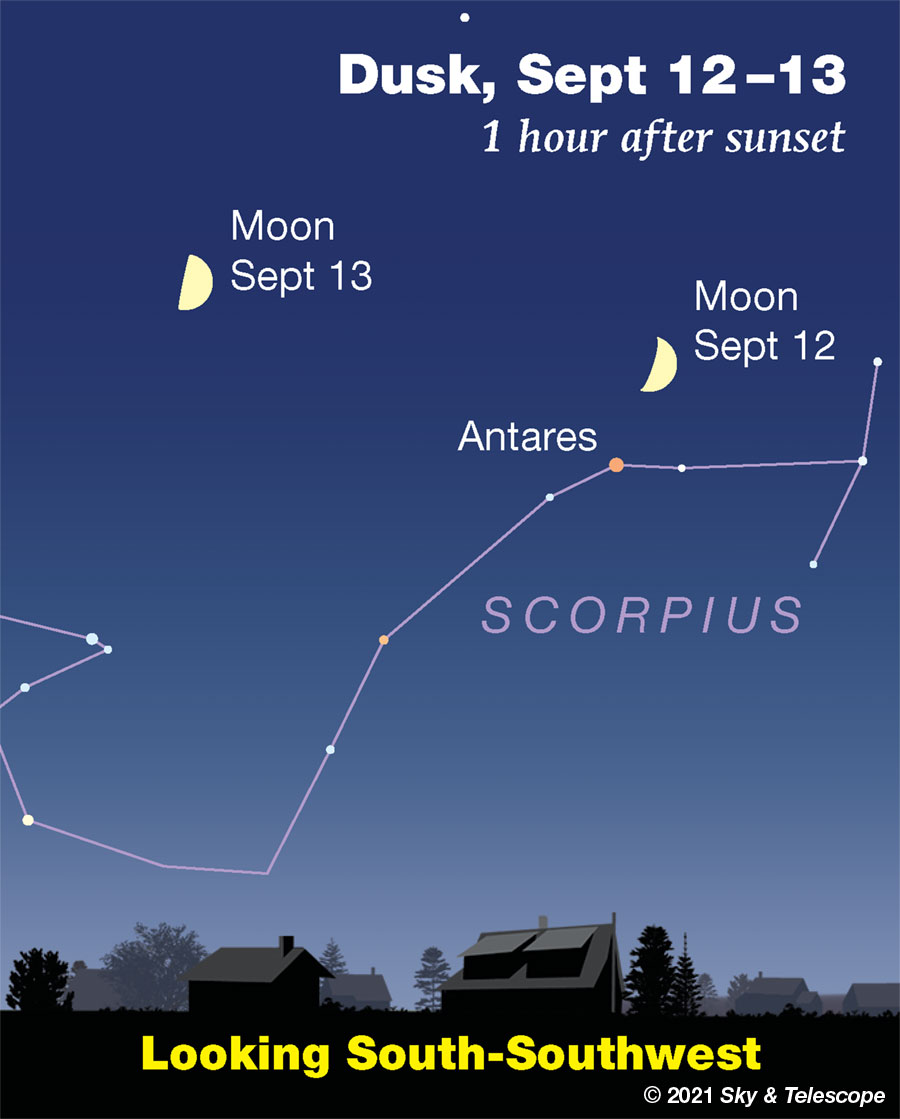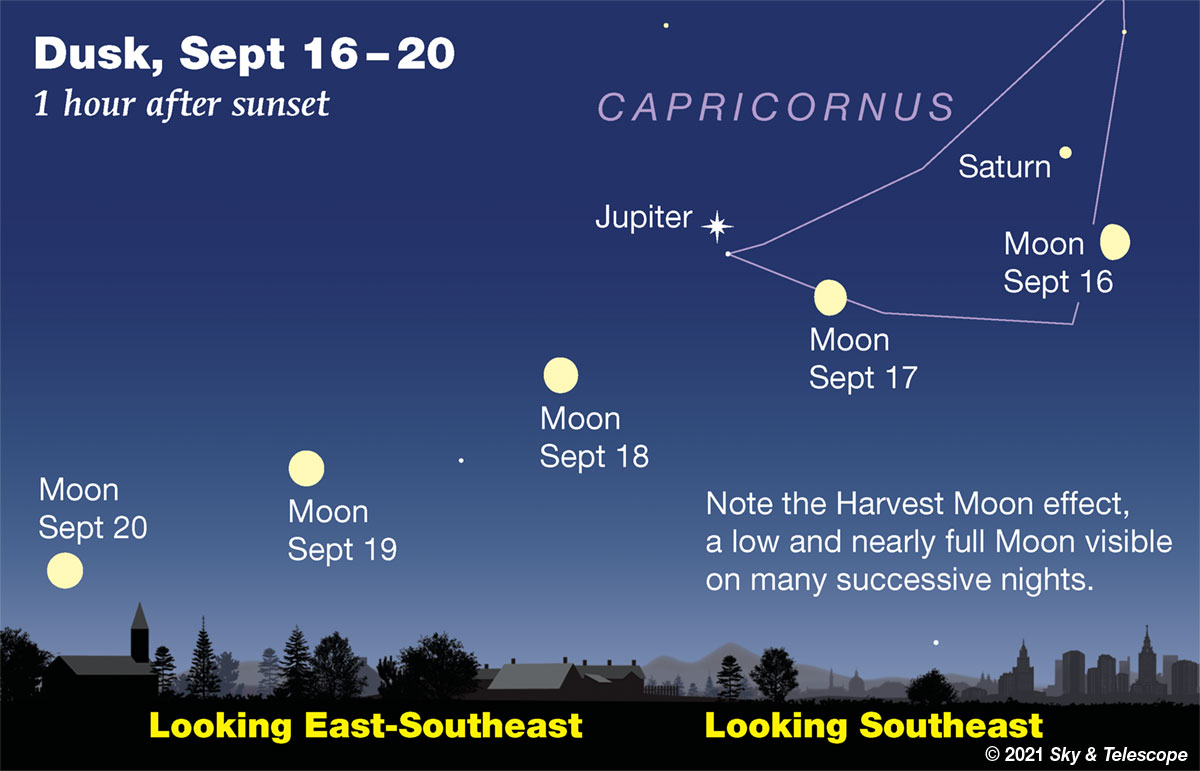The recurrent nova RS Ophiuchi has faded down past magnitude 9.0 as of September 10th. But Nova Cassiopeiae 2021 has jumped up yet again, to 6.6 on that date, a magnitude brighter than its original explosion last March. This is its seventh bump-up since March. It won't quit! It's now classed as a "very slow nova." Charts and comparison stars.
FRIDAY, SEPTEMBER 10
■ We continue to have three bright evening planets this week: Venus low in the west-southwest at dusk, Jupiter higher in the southeast to south during evening, and dimmer Saturn nearly two fists to Jupiter's right. By late evening, faint Uranus and Neptune lurk high in the east.
■ The two brightest stars of September evenings are always Vega high overhead and Arcturus in the west, both magnitude zero. Draw a line from Vega down to Arcturus. A third of the way down you cross the dim Keystone of Hercules. Two thirds of the way you cross the delicate semicircle of Corona Borealis with its one modestly bright star: Alphecca, the gem of the crown.
SATURDAY, SEPTEMBER 11
■ Look left of the thick crescent Moon for the head stars of Scorpius lined up not quite vertically, and farther left for orange Antares. Halfway between the Moon and Antares (for the Americas) is the brightest of the head stars, the long-term eruptive variable Delta Scorpii. It's been holding fairly steady around magnitude 1.8 since 2010.
Delta Sco is one of the Gamma Cassiopeiae class of hot variable stars spinning at nearly breakup speed. Read about the original at Meet Gamma Cassiopeiae, the Classic Eruptive Variable.
SUNDAY, SEPTEMBER 12
■ Now the Moon shines upper right of Antares. as shown below. They're about 3° apart in early evening for the Americas.

MONDAY, SEPTEMBER 13
■ First-quarter Moon (exact at 4:39 p.m. EDT), shining in the feet of Ophiuchus. The Moon is about midway between Antares to its lower right and the Sagittarius Teapot to its left (for North America). Look soon after twilight ends, before they sink lower.
TUESDAY, SEPTEMBER 14
■ Now the Moon shines in the lid of the Sagittarius Teapot. The Teapot is tilting and pouring to the right, like always in September. Binoculars will help you pick it out from moonlight and light pollution. (Remember that the Teapot spans some 13°, about twice the width of a typical binocular's field of view.)
WEDNESDAY, SEPTEMBER 15
■ Jupiter, Saturn, and the waxing gibbous Moon form a gently curving line this evening, with the Moon on the lower right. Extend a line from Saturn through the Moon by the same amount onward, and you're in the Sagittarius Teapot.
THURSDAY, SEPTEMBER 16
■ Now the Moon shines about 5° under Saturn, as indicated below. (Actually, the "Harvest Moon effect" more often refers to the Moon continuing to light the early-evening landscape for several days after full near the September equinox. Before full the Moon lights the early evening every month, though it's not necessarily low.)

■ Polaris crosses a line. Roger Sinnott, Sky & Telescope's longtime master of all things celestial-mechanical, writes, "I discovered a neat curiosity when working on the Skygazer's Almanac for 2021. Owing to precession, on September 16th Polaris reaches right ascension 3h (equinox of date) for the first time in 26,000 years, after having crossed 2h in 1964 and 1h in 1828.
"Of course, this doesn't have any profound ramifications. But Polaris's changing R.A. is very noticeable when you look it up in star charts or catalogues for equinox 2000.0 vs. 1950.0. It also shows up easily when you compare the 2021 Skygazer's Almanac [our annual events-through-the-night chart, which comes with every January's S&T ] with those from 10, 20, or 40 years ago. The nearer Polaris gets to the celestial pole, the more rapidly its R.A. changes."
FRIDAY, SEPTEMBER 17
■ And now the gibbous Moon hangs lower right of the bright Jupiter at dusk, as shown above. Later in the night, as the sky turns, The Moon becomes directly below Jupiter. That's how you'll find them around midnight (daylight saving time).
SATURDAY, SEPTEMBER 18
■ You can see in the stars that the season is changing: We've reached the time of year when, just after nightfall, cold-weather Cassiopeia has already climbed a little higher in the northeast than the warm-weather Big Dipper has sunk in the northwest. Cas bedecks the high northern sky in early evening during the fall-winter half of the year. The Big Dipper takes over for the milder evenings of spring and summer.
Almost midway between them stands Polaris. It's currently a little above the midpoint between the two.
.
This Week's Planet Roundup
Mercury (about magnitude +0.2) is very deep down in the sunset, 16° lower right of Venus this week. You might have a chance at it with binoculars or a wide-field scope. About 15 or 20 minutes after sunset, scan for it just above your horizon due west. Good luck.
Between Venus and Mercury is fainter Spica, magnitude +1.0.
Venus, brilliant at magnitude –4.1, shines in the west-southwest during twilight. It still sets around twilight's end.
Jupiter and Saturn shine in the southeast to south these evenings. They're magnitudes –2.8 and +0.4, respectively, on opposite sides of dim Capricornus.
Jupiter starts the evening as slightly the lower of the two. Saturn glows 17° (almost two fists) to Jupiter's upper right. They level out around 9 or 10 p.m. daylight-saving time. By then they're about at their highest in the south at their telescopic best. After that they start to tilt the other way, with Saturn now the lower one.
Look for 1st-magnitude Fomalhaut about two fists (22°) to Jupiter's lower left. And this week, Jupiter is passing 1½° north of 3rd-magnitude Delta Capricorni.
Uranus (magnitude 5.7, in southern Aries) gets high in the east after midnight.
Neptune (magnitude 7.8, at the Aquarius-Pisces border) is high in the southeast by 10 p.m.
All descriptions that relate to your horizon — including the words up, down, right, and left — are written for the world's mid-northern latitudes. Descriptions that also depend on longitude (mainly Moon positions) are for North America.
Eastern Daylight Time, EDT, is Universal Time minus 4 hours. Universal Time is also known as UT, UTC, GMT, or Z time. To become more expert about time systems than 99% of the people you'll ever meet, see our compact article Time and the Amateur Astronomer.
Want to become a better astronomer? Learn your way around the constellations. They're the key to locating everything fainter and deeper to hunt with binoculars or a telescope.
This is an outdoor nature hobby. For an easy-to-use constellation guide covering the whole evening sky, use the big monthly map in the center of each issue of Sky & Telescope, the essential magazine of astronomy.
Once you get a telescope, to put it to good use you'll need a detailed, large-scale sky atlas (set of charts). The basic standard is the Pocket Sky Atlas (in either the original or Jumbo Edition), which shows stars to magnitude 7.6.

Next up is the larger and deeper Sky Atlas 2000.0, plotting stars to magnitude 8.5; nearly three times as many. The next up, once you know your way around, are the even larger Interstellarum atlas (stars to magnitude 9.5) or Uranometria 2000.0 (stars to magnitude 9.75). And be sure to read how to use sky charts with a telescope.
You'll also want a good deep-sky guidebook, such as the big Night Sky Observer's Guide by Kepple and Sanner.
Can a computerized telescope replace charts? Not for beginners, I don't think, and not on mounts and tripods that are less than top-quality mechanically, meaning heavy and expensive. And as Terence Dickinson and Alan Dyer say in their Backyard Astronomer's Guide, "A full appreciation of the universe cannot come without developing the skills to find things in the sky and understanding how the sky works. This knowledge comes only by spending time under the stars with star maps in hand."
![]() Audio sky tour. Out under the evening sky with your
Audio sky tour. Out under the evening sky with your
earbuds in place, listen to Kelly Beatty's monthly
podcast tour of the heavens above. It's free.
"The dangers of not thinking clearly are much greater now than ever before. It's not that there's something new in our way of thinking, it's that credulous and confused thinking can be much more lethal in ways it was never before."
— Carl Sagan, 1996
"Facts are stubborn things."
— John Adams, 1770
 4
4









Comments
Rod
September 11, 2021 at 9:33 am
I was able to do some stargazing last night. Observed 2030-2200 EDT/0030-0200 UT. First Quarter Moon 13-Sep-2021 2039 UT. Observed using 14-mm with 90-mm refractor at 71x. Good views of Jupiter and Galilean moons along with many cloud bands visible. No filters used and Jupiter still bright. The Galilean moons were in tight pairs on each side of Jupiter this evening. Saturn lovely with rings and Titan easily visible. M2 fuzzy
ball with some 10.4 magnitude stars nearby its position visible. Near 2100 EDT, a 5th magnitude satellite passed by the FOV of M2. M15 a bit larger size and also some 10th magnitude stars visible in FOV nearby its position. Starry Night and Stellarium showed the star magnitudes. Both globular clusters nice view as fuzzy balls but the 10-inch does the best job on the globular clusters. A good, relaxing evening of viewing some globular clusters, Jupiter and the Galilean moons, and Saturn. When I ended my viewing session, my feet were wet and grass very wet from the dew all over. Limiting magnitude eye test. I could see Kappa Delphini but difficult. Stars visible tonight near 5th magnitude, not 5.5 or 5.6. Temperature 15C or a bit cooler. Heavy dew formed fast all over the fields and pastures.
You must be logged in to post a comment.
GaryN
September 12, 2021 at 2:16 pm
Forest fire smoke looks to be clearing for me in the next day or so. Looking forward to observing M2 after moonset. Don't forget to check the transparency forecast on https://www.astrospheric.com since it's the only one that takes smoke into account!
You must be logged in to post a comment.
Rod
September 12, 2021 at 4:12 pm
Very good GaryN. I book marked site you reference. I view in Maryland south of Annapolis area along the Patuxent river, more rural and open/farming areas. No street lights or bright lights nearby my location. The map shows much smoke over Maryland now and that is what I thought caused viewing issues. I have had problems with the high altitude smoke now, off and on this summer. M2 and M15 look excellent in my 10-inch Newtonian at 86x to 155x views. The 90-mm view was good but fuzzy balls. Jupiter and Saturn were excellent though.
You must be logged in to post a comment.
mary beth
September 14, 2021 at 12:18 pm
Hello all! Rod, it’s great to see your report and I’m glad you had some nice viewing. Gary’s link is interesting and helpful. We had a pretty bad night last night with the storm and the winds gusting almost to 70 mph here in Houston. Thank God no damage to our home. Did see the beautiful crescent moon low on Friday evening, the color was golden orange and it was spectacular! We had a very colorful sunset Sunday. Hopefully we will clear off so we, and others, can enjoy the harvest moon!
You must be logged in to post a comment.
You must be logged in to post a comment.